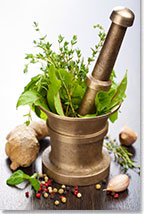 Keep your herbs fresher, longer (and chop them in record time) with these smart strategies. First, the good news: You’re probably cooking with fresh herbs. That means you already have a leg up on cooks from a few decades ago, most of whom relied on dried herbs in jars that weren’t replaced nearly as often as they should.
Keep your herbs fresher, longer (and chop them in record time) with these smart strategies. First, the good news: You’re probably cooking with fresh herbs. That means you already have a leg up on cooks from a few decades ago, most of whom relied on dried herbs in jars that weren’t replaced nearly as often as they should.
The bad news? You’re probably prepping them wrong. Yes, sure, you can flail a chef’s knife at a pile of herbs and get the leaves cut down to size. But you risk bruising the herbs or—worse—throwing away some perfectly edible (and majorly flavorful) odds and ends. So let’s get to it, shall we?
Actually, wait. Before we get to the chopping, there’s some prep we need to do. Because you can’t chop your herbs until they’re washed and fully dry. This is crucial. Wet herbs—even slightly damp herbs—turn to mush when you chop them. So fill a clean sink with cold water and gently swish the herbs around in there. Any dirt will fall to the bottom, and the herbs will float on top. Pull them out, give them a spin in a salad spinner or a hearty shake, and you’re almost good to go.
But not quite. Even after spinning in a salad spinner or shaking by hand, fresh herbs will still have some water on them. So spread them out on a paper towel or a clean, absorbent kitchen towel and let sit until completely dry. (Actually, the best way to achieve this is to wash and dry your herbs the minute you get them home. But you’re busy. I get it. So am I.)
Okay. Now here’s The Epicurious Guide to Chopping Herbs.
For Parsley, Dill, or Cilantro: No need to pluck off just the leaves—the thin part of the stem is edible (and extremely delicious). Just chop off and discard the thick, bottom part of the stems. Then chop up the remaining stem as you chop the leaves. (Pro tip: If you’re not using the stems, freeze them and save them for later. Without the tender leaves attached they freeze well, and they’re a great addition to your stock pot, or pureed into pestos.)
For Mint, Basil, or Sage: Pick the leaves off their woody stems, then gently tear into pieces (this avoids the bruising you can get with knife-chopped herbs). Or make thin little ribbons (a.k.a. chiffonade): Stack the leaves, roll them into a tight bundle, and slice crosswise with a sharp knife.
For Thyme, Rosemary, Oregano, or Tarragon: To quickly strip the leaves from their stems, hold a single sprig at the top, pinch the stem with two fingers, and quickly run your fingers down the stem to remove all the leaves. Bunch all the leaves into a pile, then mince to desired size. (Thyme is often small enough to not need any chopping.)
For Chives: Chopping just makes chives mushy, so you want to slice them instead. You want to keep the circle whole for chives, so there’s really only one way to cut them: across the length of the stem. A knife works, but the best tool for this? Kitchen scissors.